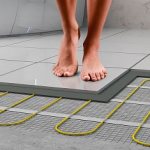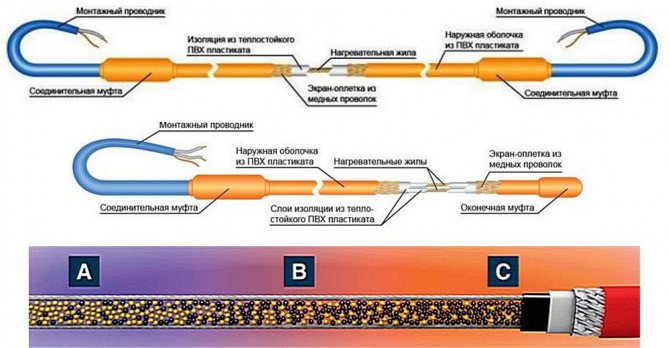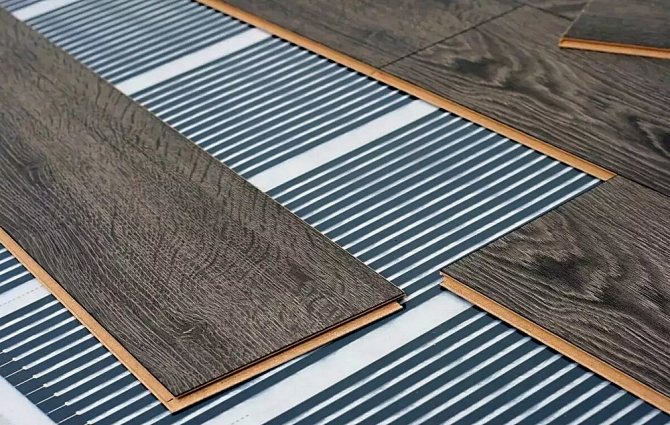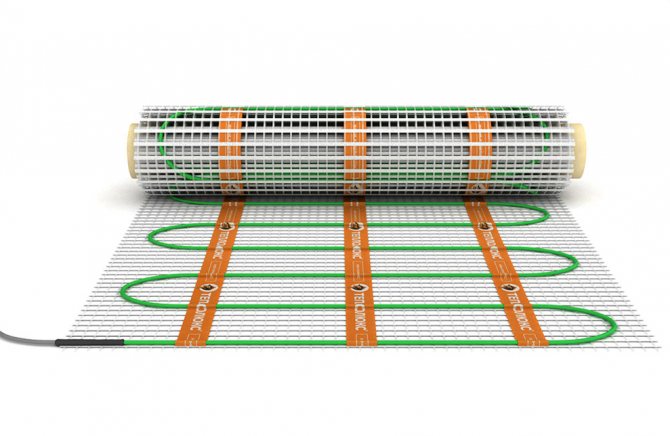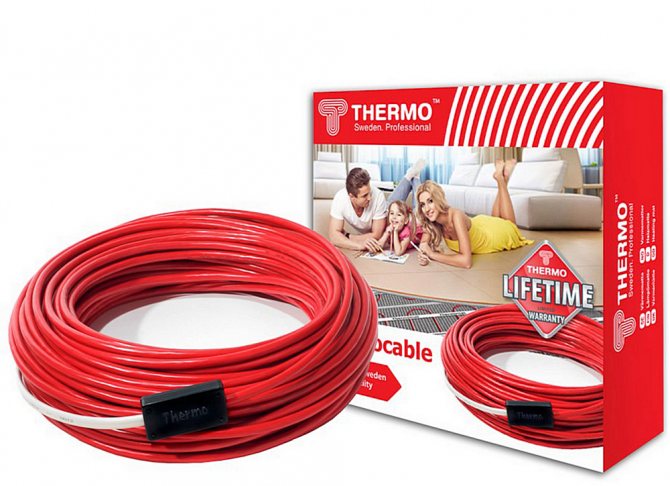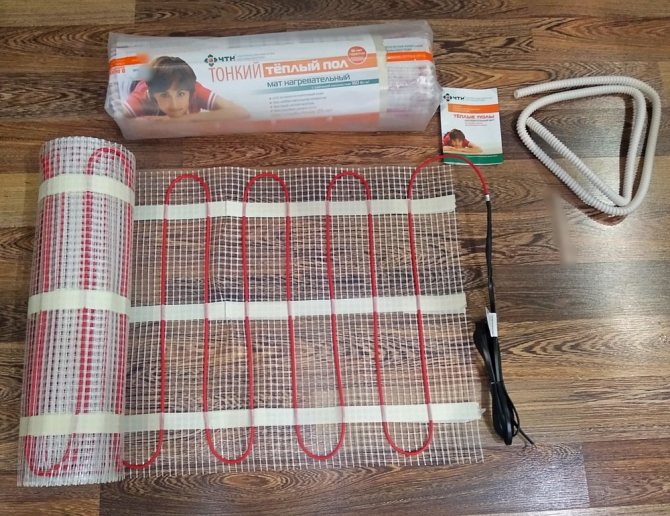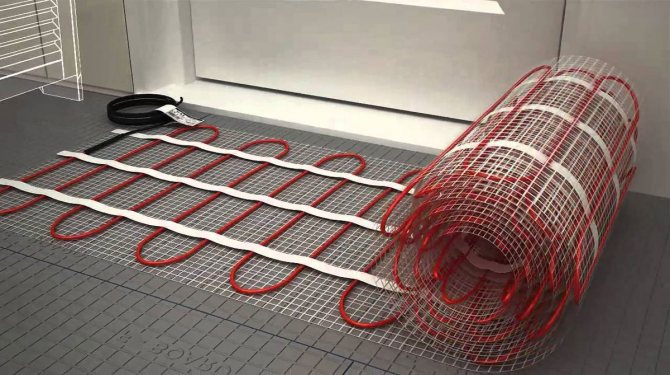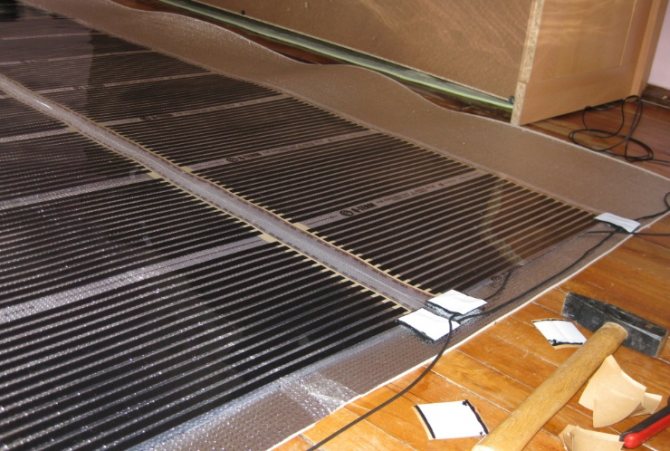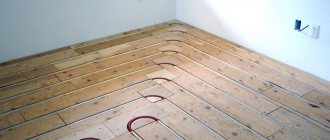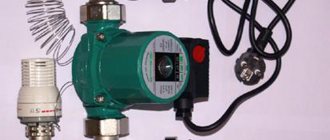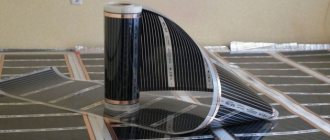Types of electric underfloor heating
Today on the market there is a huge range of electric type floor systems. All of them are divided into several types.
Below we will analyze in detail the technical characteristics of each type, calculate the electricity consumption depending on the type of premises per 1 m2 per hour, per month. We will also find out how the finish coating affects energy consumption.
Electrical cable
An electrical cable is a wire that can be laid arbitrarily, but more often according to the "snail" or "snake" scheme. From above, the structure is poured with a concrete screed, which reduces the height of the room by an average of 5 cm. The specific power of such a cable is from 0.01 to 0.06 kW / m2, its choice depends on the frequency of turns.
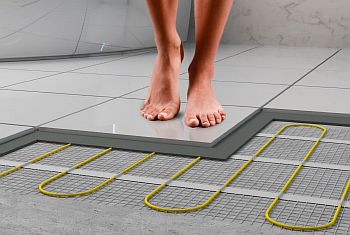
The power consumption of one meter of cable is from 10 to 60 W. To cover 1 m2 of surface, about 5 meters of wire is required, thus, for heating, an average of 120-200 watts of electricity is needed.
Thermomats
Heating mats are a construction made of cable, which is laid according to a certain pattern on a special mesh. It is more often installed under the screed, and is perfect for laying in rooms with high humidity.
This model is intended for rooms with low ceilings, since the thickness of the "cake" is only 3 cm. The power of the mat is up to 0.2 kW / m2.
The average power consumption per square meter of the heating mat is 120 - 200 W.
Infrared film
Infrared underfloor heating - a thin polymer film with an applied carbon layer. When heated, carbon emits heat.
IR foil does not affect ceiling heights. On average, about 150 - 400 W of electricity is wound to warm up 1 m2 of film.
Rod floor
Rod floor - refers to the infrared type, only contains rods instead of carbon plates. Its power consumption is 120 - 200 W per square meter.
Heating element power
The main types of electric floor heating are film (infrared), thermomat and heating cable. As for the film coating, it is customary to use it when laying the system under laminate and linoleum, mats and cables are used for heating ceramic tiles. Each of the listed heating elements has its own characteristics: power, thickness, heating temperature, etc. Now we will consider how much electricity each type of heated floor consumes.


So, the energy consumption of the heating elements is as follows:
- film coating - from 150 to 400 W / m2;
- heating cable - from 10 to 60 W / meter (30 W on average). Usually, about 5 turns of material are laid on 1 square meter of the surface, so that the total power is 120-150 W / m2;
- thermomat - from 120 to 200 W / m2 (average consumption is taken according to the characteristics of DEVI and TEPLOLUX floor heating manufacturers).


As you can see, the power of an electric underfloor heating is on average from 120 to 200 W / m2, which makes it possible to make a system for both full heating of the room and for an auxiliary one.
Video review of how much the heating system consumes
Calculation of electricity costs by type
To determine how much an electric underfloor heating consumes current, consider a number of the following factors: heat loss, base thickness and the degree of thermal insulation of the room.
The formula will help you calculate the amount of electricity consumed:
W = S * P * 0.4, where
- S - area in m2;
- P - power;
- 0.4 is the coefficient of the heated useful area.
Electric cable and mats
To determine the amount of electricity consumed and the cost of paying for it during the operation of the cable system, it is necessary to take into account a number of points:
- The size of the heated area is a free part of the room without furniture. Usually it is 12 - 15 sq. m., it is there that the cable or mats will be laid.
- To heat 15 m² of floor, on average, a wire is required with a total power of 2100 W / h. More often, consumers purchase foreign products designed for a voltage of 230W. In our conditions, such a cable cannot function at full strength. It is capable of consuming no more than 1930 watts.
- 1930 W is the power consumed by a warm cable floor at maximum load. In this case, the heating temperature can reach + 45 ° С. A comfortable temperature is considered to be up to + 23 ° С. A floor in such conditions can consume about 965 watts.
- According to calculations, to maintain a comfortable atmosphere, it is necessary to heat the cable for 20 minutes every hour. As a result, the power consumption for heating 1 m2 of floor is no more than 322 W / h.
It is possible to pay less for the energy consumed by a cable warm electric breaker if you use a two-tariff meter.


In addition, when using a cable, to determine the amount of electricity consumed, you need to calculate its length. This can be easily done using the formula:
L = l / a
Where:
- l - wire length:
- a - the step between the cable loops.
Multiplying this value by the power of the wire (120-200 watts), you will get the amount of electricity consumed by a heated floor per 1 m2.
Infrared floor heating
If infrared warm floors are used, then the degree of preparation of the room affects their energy consumption, as in the functioning of any heating system. In addition, film power is considered an important factor. When using the device as main heating - 220 W / m2, if additional - 150 W / m2.
For your information! Film 220 W per hour needs to be warmed up for 5 - 7 minutes, and 150 W - 12 minutes. At the same time, they will consume electricity in the same way on average.
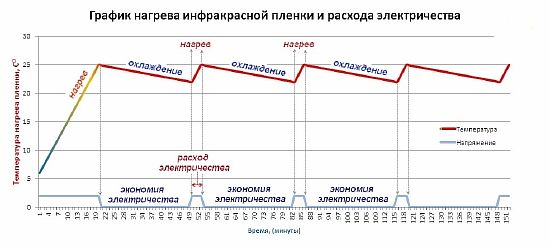

How much energy is consumed by warm film floors per month, let us consider the example of a room of 50 square meters, with a film power of 150 watts. For this:
W = 50 * 150 * 0.4 = 3000 W or 3 kilowatts in 60 minutes.
To calculate your monthly consumption, you need:
3000/60 minutes x 5 minutes (running time per hour) x 12 hours per day x 30 days per month = 90,000 W / month or 90 kW
The resulting indicator is multiplied by the tariff of your region - so much you will spend on paying for light in money. Naturally, this figure is approximate, and when using the counter "day - night".
With the correct calculation and planning, costs can be significantly reduced.
Calculation method No. 2
To independently determine the energy consumption of a "warm floor", you must use the formula below:
PxSx0.4 = W
In this case, P is the power of a particular heating system, S is the area of the heated room, and 0.4 is an indicator that takes into account what part of the entire floor covering is covered with heating material. Simply put, Sx0.4 is the useful heating area.
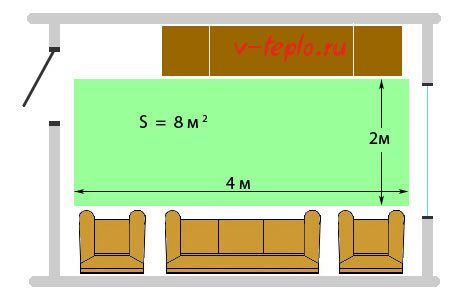

And now, for clarity, we will give one more small example. Let's say we need to determine the approximate consumption of electrical energy for a "warm floor", the power of which will be 150 watts per hour, for a room with an area of 25 squares. In this case, the required formula will look something like this:
150x25x0.4 = 1.5 kilowatts (this is our W coefficient). Consequently, the energy consumption will be somewhere around 1.5 kilowatts per hour. The same as in the previous calculation method.
Note! We have already figured out the consumption of electrics per hour, but that's not all. As we have already found out, the heating system will not work all day, but only for 8 or 9 hours a day, that is, when all tenants are at home.
It follows from this that during the day the electricity consumption for heating will be approximately 12-13 kilowatts. Having made simple calculations, we find out that the consumption of such a "warm floor" per month will be equal to 360-390 kilowatts.
Let's make a reservation right away that the above calculations are inaccurate and rough, and real consumption will be at least half as much as stated above. This is due to the possibility of additional use of thermostats, which allow another 40 percent to save energy consumption.
Therefore, regarding how much electricity the warm floor consumes, we can say that instead of 360 there will be only 250 kilowatts. Moreover, in the example, a power of 150 watts was used, but you can easily use a cable with parameters of 120 or even 90 watts per hour, because for individual use this should also be enough!
Heating temperature regulators
We advise you to familiarize yourself with our guide, about what temperature regulators are and what points you should pay attention to when choosing, see the details here
After all this, we just have to multiply the power consumed by the "warm floor" during one month by the price of a kilowatt of electricity in your region. As a result, we will get the ready consumption of the heating system, on the basis of which we can determine whether it is profitable or not. As you can see, there is nothing complicated in these calculations, and using the above formula, you can determine the energy consumption for any room - living room, kitchen, bedroom, etc. The main thing is to have a calculator at hand.
It should also be noted that if the calculations are made in relation to the infrared floor, then the fact must be taken into account that an approximate power of 60 watts is required per square meter of a room that is not heated. And if the room is heated, then this coefficient is reduced to 30 or even 20 watts. This is explained by the fact that the efficiency of this material is high, while the consumption of electricity, on the contrary, is low. This, in fact, is the main advantage of the film floor over other options.
Energy costs depending on the topcoat
When choosing a finishing material for laying on a warm electric floor, it is necessary to have a pictogram on the product, which indicates the possibility of being adjacent to a heating device. Most often, ceramic tiles, linoleum or parquet are laid on floor heating systems.


It is worth noting that the level of electricity consumption of 1 square meter of a warm electric floor is also affected by the finish, or rather its thermal conductivity. When choosing a laminate or board, your heating costs will rise, as they have a low degree of thermal conductivity.
But ceramics, linoleum or carpet are an ideal and economically viable material. Surface heating is carried out quickly, and a minimum amount of resource is spent on this.
Calculation of energy costs by electric floors, depending on the type of premises
There are certain standards according to which a device of its own power is recommended for each room:
- in living rooms, kitchen and corridor - up to 120 W per m2;
- in the bathroom - 150 W / m2;
- in the loggia - 200 W / m2.
In addition, the power of the system is influenced by its purpose - it will be the main or additional heating.
For example, if a warm floor is the main source of heat in a room with an area of 20 m2, with a usable area of 8 m2, then the heat loss will be equal to 2 kW / hour. Based on these data, the power is calculated:
- heat loss / area = 2/8 = 0.25 kW / m2
If you live in a region with a harsh climate, add 25%.
Comparative analysis of the consumption of warm floors by type
In all electric floors, induction heating of the surface is carried out, that is, using an electric current. Conversion of electricity into thermal energy takes place with approximately the same efficiency. The size of the energy consumption of the warm floor is influenced by the installation method and the floor covering.
The following factors are of great importance:
- Thermal insulation and reflectivity of the underlying material;
- The degree of heat loss in the screed is important for screed structures.
After analyzing the above, we can summarize that:
- the most energy efficient heating devices are placed directly under the decorative item;
- laying high-quality insulation with a reflective surface and isolating the edges of the screed from the walls will reduce the differences between the models in terms of cost-effectiveness.
Despite the slight discrepancy in the level of electricity consumption of different types of electric floors, there are still differences. The most significant consumption of the film is 220 W / m2, the degree of maximum heating is +40 degrees.
When installing the cable in a screed - 150 W / m2. Therefore, if the design allows it, it is more economical to lay the cable system in a tie. With well-made thermal insulation, the device will warm up the screed for about 8 hours, and then it will give it to the room.
However, this difference in the consumption of electric current by different types of systems is not significant, when they are laid in rooms of a small area. The costs of installing them throughout the apartment differ significantly.
Underfloor heating classifications
There are two main types of underfloor heating:
- Water;
- Electric.
The electric floor has 3 types:
- Single core cable. The entire system consists of a one-piece cable without a bonding substrate and joints;
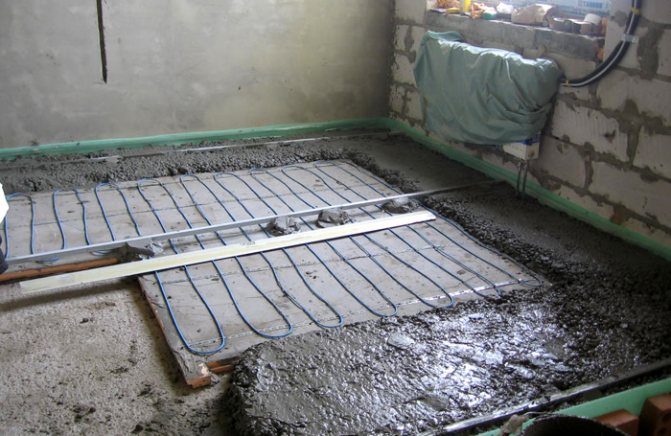

Self-planning "pattern", budget option
- Electric mats:
- Carbon fiber. It is a two-core system, connected by conductors;
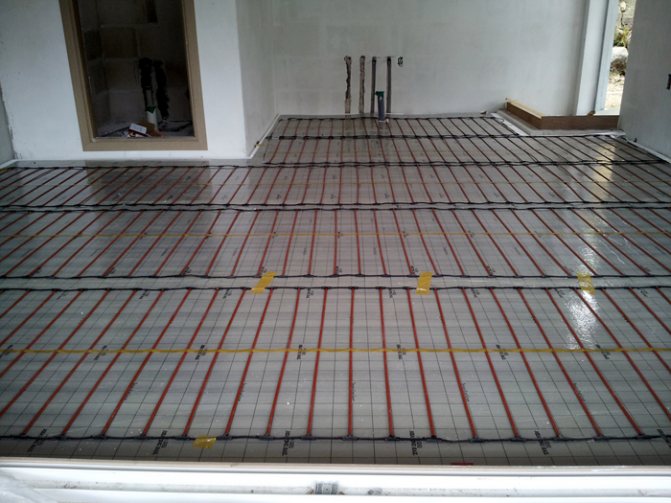

Example of mounting carbon material
- Cable. It is a one-piece cable system attached to an anchor pad;
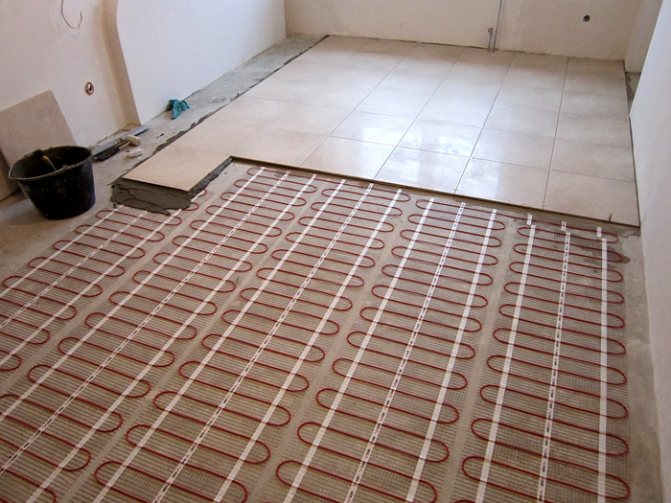

Laying cable mats under tiles
- Infrared electric thermal film.
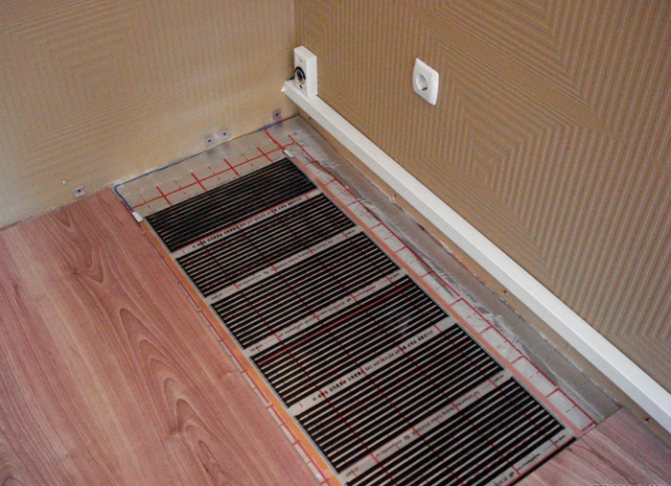

An example of laying a film floor
Comparison of functional characteristics
All classifications of a warm floor can be compared in different directions: installation time, financial costs, electricity consumption, heat distribution, etc.
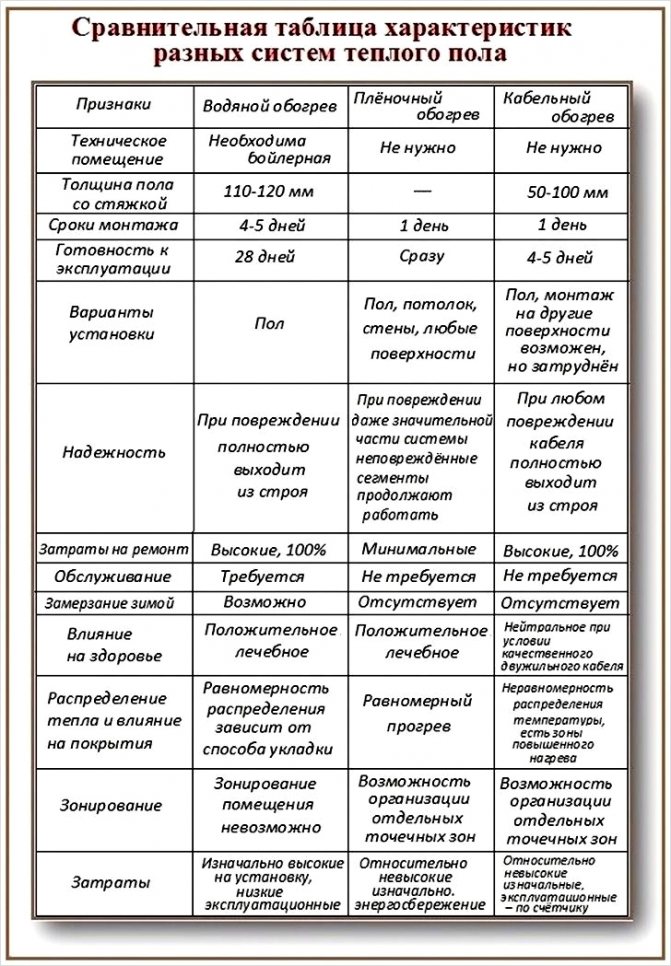

Comparison table of functionality of water and electric heating systems
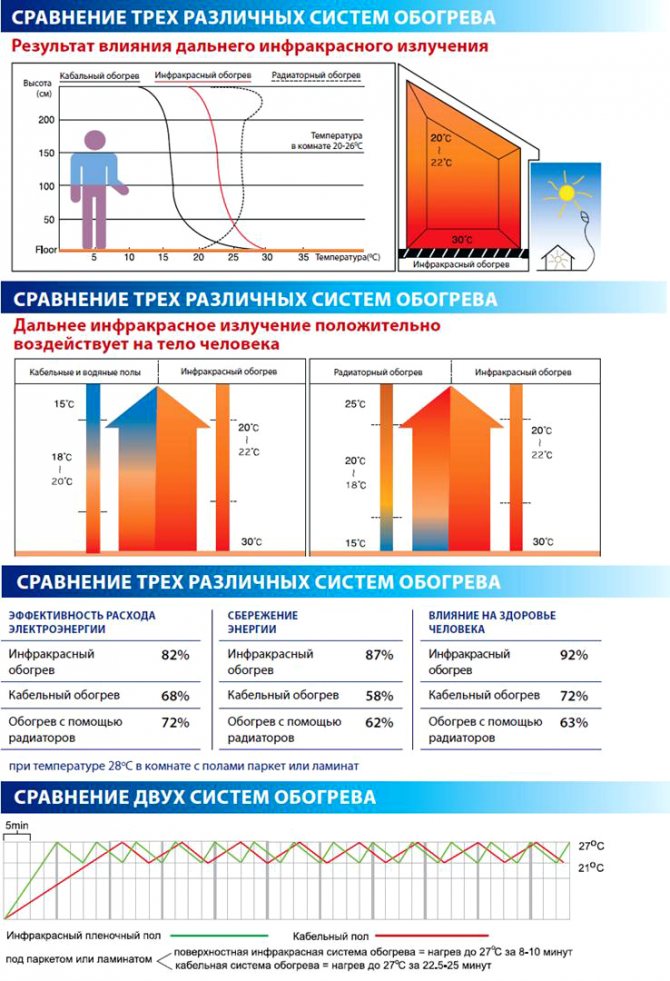

Table of heat distribution in a room and the effect of infrared radiation on a person
Note! It is not recommended to lay the film floor under the tile, as liquid glue or screed in this case does not have a sufficient area of contact with the base and the surface will "float" and then crack. Also, alkaline compounds in tile adhesive can destroy the integrity of the protective film. A suitable option for installation under a tile is a cable underfloor heating.
Related article:
Wiring diagrams of water-heated floors in a private house. Before starting work, you should study the possible installation and connection schemes. A special publication of our portal will help you.
Advantages of film material
The undoubted advantages of a film floor over a cable analogue or a water-heated floor are:
- Easy styling process;
- Since there is no screed, the height of the room remains practically unchanged;
- Failed sections do not interfere with the further operation of the entire system. Damaged elements can be easily replaced without dismantling the entire system;
- Since the surface of the film floor heats up everywhere, it will not be difficult to find an area with damaged sections.


Positive aspects of the film sample
The energy consumption of a film underfloor heating depends on the power and, as a rule, has the same characteristics as a cable floor. Reviews about power consumption are easy to find on the net.
Factors that reduce energy consumption
As already mentioned, when installing electric underfloor heating in all rooms of the apartment, the cost of payment will be impressive, which will affect your family budget.
However, there are ways to reduce energy consumption:
- Carrying out high-quality insulation - good thermal insulation reduces consumption by 35 - 40%.
- Installation of a multifunctional meter - the cost of electricity used at night is about 2 times lower. Moreover, the heating mainly works when there are people in the house, and this is usually evening and night.
- Install underfloor heating in a free area. Laying it under furniture is not only unprofitable, but also prohibited by the system manufacturer.
- Use of finishing coatings with good thermal conductivity.
- Installing a programmable thermostat - especially in residential premises, will save a third of energy costs.
- In rarely inhabited rooms, not maintaining a high degree of heating is an unnecessary winding of energy.
In addition, if you reduce the degree of heating by only 1 degree, then this will not affect the atmosphere in the room much, but the savings will be 5%.
Climatic conditions are also of great importance. The greater the difference between the temperature in the room and outside the window, the higher the power consumption of electricity increases.
Thermostat is an indispensable device for reducing costs
Separately, it should be said about the thermostat - its use can reduce power consumption by up to 40%. It is recommended to install the device in the coldest part of the room. When the temperature drops below the set value, it will turn on the heating, and when the desired value is reached, turn it off.
For your information! Most of the regulators are designed for a voltage of 10 amperes, such a device can withstand a load of no more than 2300 watts.
In many ways, the type of thermostat affects the consumption of electricity, they are:
- mechanical - the design is simple and inexpensive, the daily working time is about 12 hours;
- programmable - equipped with several modes that allow you to control the work, such a device operates only 6 hours a day.


For example, consider what type of thermostat will be more economical. To do this, we will use the formula:
Рд = t * Ptot;
t is the operating time of the device;
Ptot - power.
When installing a 900 W mat and using a mechanical type regulator:
Pd = t * Ptot = 12 h * 900 W = 10 800 W = 10.8 kW
If a program controller is installed, then:
Pd = t * Ptot = 6 h * 900 W = 5 400 W = 5.4 kW
From this calculation it can be seen that the use of a programmed regulator will significantly reduce your costs.
If the warm floor acts as the main heating in all rooms, then several controllers will need to be installed, which are connected to one centralized system.
Thinking about installing an electric floor in a house or apartment, you should carry out all the required calculations, taking into account the maximum load in winter. Only after weighing all the pros and cons, you need to decide on the installation of such a design.
How to reduce resource costs
It is possible to reduce the cost of electricity bills if we take into account all the nuances of the underfloor heating. With insufficient thermal insulation at home, no tricks will help.
Correct thermostat installation


The sensor and thermostat must be installed in each room and adjusted separately
How much energy is consumed by the warm floor depends on the type and method of installation of the control device. The recommendations are as follows:
- The settings of the electronic device are precise: the temperature can be set up to 1 degree. This is a more economical mode of operation.
- A programmable thermal sensor lowers the temperature when the inhabitants of the dwelling are not at home. In this way, energy can be saved up to 30%.
- Mount the device in the coolest place.
- A thermostat is installed in every room, since the comfortable temperature in the bathroom and bedroom is different. If heating in different rooms is controlled by only one device, all rooms will be heated in the same way, and this leads to excessive consumption.
The thermostat is adjusted using a floor sensor.Programmable can be configured to operate from 2 sensors. In this case, the floor heating is regulated depending on the air sensor indicator, and the floor sensor serves as a limiter and does not allow the temperature to rise above 28-30 C.
Heating of the usable area
There is no need to heat the floor under furniture or equipment. Cables or IR foil should be laid only on open areas of the floor, where a person comes into contact with the coating. This area is called useful or active.
Heating elements are mounted at a distance of at least 20 cm from the wall - the size of the usable area is also reduced due to compliance with the limitation.
Multi-tariff meter


Three-rate meter to reduce costs during night and working hours
A two- and three-tariff meter takes into account the amount of electricity consumed depending on the time of day: during the day, at night, during the morning peak. The cost of electricity differs at different times of the day. 1 kW of nighttime energy costs 50–70% less than daytime energy. In the morning and in the evening, the price is the highest.
The multi-tariff meter in combination with the programmed operation of the temperature sensor reduces the cost of night heating by accounting for a different tariff and by reducing the temperature.
Building insulation
Thermal insulation is the main condition for lower consumption. All elements of the structure are subject to insulation:
- poorly designed walls let up to 30% pass;
- 20% of heat is lost through the non-insulated foundation;
- a cold roof, even taking into account the attic, allows up to 25%;
- a window in an old wooden frame loses up to 25%;
- another 5% disappears through the entry points of external communications;
- ventilation provides 15% of losses.
A poorly insulated building saves no more than 30% of heat. Under these conditions, the heating costs are enormous. On the contrary, reliable thermal insulation keeps you warm, like a thermos of hot tea. In mid-latitudes, during warm winters, an underfloor heater can replace the standard water system while operating in auxiliary heating mode.
Reducing room temperature
The maximum permissible floor heating temperature is high - at the outlet, the air sensor can show 30 C. This is a lot. According to statistics, the temperature is more often set in the range from 23-25 C. In fact, a comfortable environment remains at lower rates - 21-22 C. A decrease in heating by only 1 degree reduces costs by 5%.
